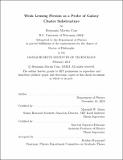Weak lensing flexion as a probe of galaxy cluster substructure
Author(s)
Cain, Benjamin Martin
DownloadFull printable version (8.731Mb)
Other Contributors
Massachusetts Institute of Technology. Dept. of Physics.
Advisor
Marshall W. Bautz and Enectali Figueroa-Feliciano.
Terms of use
Metadata
Show full item recordAbstract
Measuring galaxy cluster total masses and the amount of dark matter substructure within galaxy cluster haloes is a fundamental probe of the ACDM model of structure formation, as well as the interactions between baryonic and non-baryonic matter. In this thesis I approach the topic of cluster mass structure in two ways. With a combination of optical imaging, spectroscopy, and X-ray observations I determine that the cluster RCS043938-2904.7, while apparently anomalous initially due to its high optical richness and low X-ray surface brightness, is in fact an association of structures along the line of sight. Accounting for this structure brings the observed cluster properties into agreement with known scaling relations. I also present a novel method for measuring weak gravitational lensing flexion to inform mass measurements on small scales. While previously published methods for measuring flexion focus on measuring derived properties of the lensed images, such as shapelet coefficients or surface brightness moments, my method fits a fully mass-sheet-invariant parametrized Analytic Image Model (AIM) to the each galaxy image. This simple parametric model traces the distortion of lensed image isophotes. I tested the AIM method using simulated data images with realistic noise and a variety of input image properties, and I show that it successfully reproduces the input lensing fields. I also apply the AIM method for flexion measurement to Hubble Space Telescope observations of Abell 1689, and detect mass structure in that cluster using only flexion measured with the AIM method.
Description
Thesis (Ph. D.)--Massachusetts Institute of Technology, Dept. of Physics, 2011. Cataloged from PDF version of thesis. Includes bibliographical references (p. 129-133).
Date issued
2011Department
Massachusetts Institute of Technology. Department of PhysicsPublisher
Massachusetts Institute of Technology
Keywords
Physics.